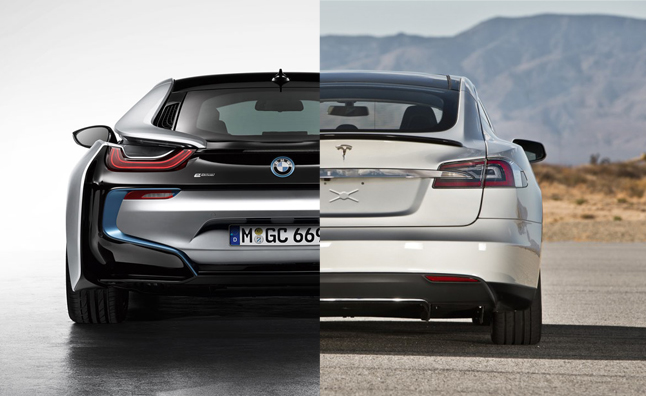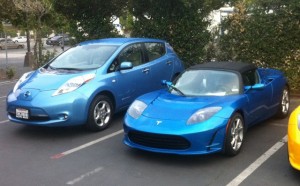News
BMW, Nissan and Tesla to Develop Universal Charging Network?

Now that Tesla has tentatively opened some of its intellectual properties (IP) to the competition and that we have some insight as to its motives, who else wants to benefit from this strategy?
Tesla welcomes the competition
Welcoming the competition might seem like a bold and dramatic move, but it is one Elon Musk has carefully planned. In the past articles, we visited what it means to open some of the company’s IP to the competition, and asked what does Tesla Motors mean by “good faith” use. We also saw this is a strategic move to once and for all cement Tesla’s role at the core of the electric vehicle (EV) industry. It also gives it a chance for its charging protocol to become a de facto standard.
BMW and Nissan
BMW has demonstrated a willingness to step into the 22nd Century, leaping over its local German competition. It has dabbled with the idea of selling directly, but is careful not to rock the boat. The matter of the fact is that BMW needs other carmakers more than Tesla does in terms of manufacturing. Case in point, its partnership with Toyota, which gives it more production capacity. BMW also gains much of a strategic alliance with Tesla.
 Nissan is the next logical choice. Already at the forefront of EVs with its best selling Nissan LEAF, which stands for Leading, Environmentally friendly, Affordable, Family car, it built and sold more electric cars than any other company in history.
Nissan is the next logical choice. Already at the forefront of EVs with its best selling Nissan LEAF, which stands for Leading, Environmentally friendly, Affordable, Family car, it built and sold more electric cars than any other company in history.
Tesla already announced last week that it had a meeting with BMW, who showed great interest. BMW is working hard to make its “ultimate driving” electric machines not only fun to drive, but feasible. And serious, BMW is. BMW bought its own carbon fiber manufacturing company and developed a sophisticated resign carbon fiber tub for its electric i3 and the stunning plug-in hybrid (PHEV) i8. I was fortunate to interview Benoit Jacobs, the head designer of the iDrive team, who revealed the gist was to have static air flow control with no electronics. Every curve and line are functional on both the i8 and i3, from the static upper windshield spoiler to the dramatic rear air diffusers. Benoit told me he wanted static aerodynamics, not electronic automation. One glance at the i8 and we can say they achieved something the Germans are not always known for, dramatic beauty. Now the real work rests on batteries and electronics, something Tesla does brilliantly.
The only problem BMW has, as well as an other recent EV I tested on CarNewsCafe is the (in)famous Combined Charging Standard (CCS) plug. CCS stations are far and few between compared to more readily available CHAdeMO, with more than 1,000 globally and the Superchargers, 100 globally. Nissan uses CHAdeMO and enjoys many more locations than CCS, but it, too, has never developed a charging network.
How come electric carmakers don’t build charging networks?
One of the many question we, journalists, ask EV makers is why they haven’t actively built a charging infrastructure like Tesla? There are many reasons, most about keeping their core competencies and ROI balanced for survival. Both BMW and Nissan would benefit tapping into Tesla’s technology and hopefully shift the power away from the idiotic charging standard war dividing manufacturers, leaving consumers to pay the price once more. If BMW and Nissan adopt Tesla’s charging protocol, the industry inexorably tilts toward a unified charging standard, leaving the CHAdeMO versus CCS battle a vestige of yesterday’s knuckle-dragging battle techniques behind. Did I make that last point strongly enough? Now imagine how the rest of carmakers and the charging industry feels.
Image source: Autoguide

Elon Musk
Elon Musk’s X will start using a Tesla-like software update strategy
The initiative seems designed to accelerate updates to the social media platform, while maintaining maximum transparency.

Elon Musk’s social media platform X will adopt a Tesla-esque approach to software updates for its algorithm.
The initiative seems designed to accelerate updates to the social media platform, while maintaining maximum transparency.
X’s updates to its updates
As per Musk in a post on X, the social media company will be making a new algorithm to determine what organic and advertising posts are recommended to users. These updates would then be repeated every four weeks.
“We will make the new 𝕏 algorithm, including all code used to determine what organic and advertising posts are recommended to users, open source in 7 days. This will be repeated every 4 weeks, with comprehensive developer notes, to help you understand what changed,” Musk wrote in his post.
The initiative somewhat mirrors Tesla’s over-the-air update model, where vehicle software is regularly refined and pushed to users with detailed release notes. This should allow users to better understand the details of X’s every update and foster a healthy feedback loop for the social media platform.
xAI and X
X, formerly Twitter, has been acquired by Elon Musk’s artificial intelligence startup, xAI last year. Since then, xAI has seen a rapid rise in valuation. Following the company’s the company’s upsized $20 billion Series E funding round, estimates now suggest that xAI is worth tens about $230 to $235 billion. That’s several times larger than Tesla when Elon Musk received his controversial 2018 CEO Performance Award.
As per xAI, the Series E funding round attracted a diverse group of investors, including Valor Equity Partners, Stepstone Group, Fidelity Management & Research Company, Qatar Investment Authority, MGX, and Baron Capital Group, among others. Strategic partners NVIDIA and Cisco Investments also continued support for building the world’s largest GPU clusters.
News
Tesla FSD Supervised wins MotorTrend’s Best Driver Assistance Award
The decision marks a notable reversal for the publication from prior years, with judges citing major real-world improvements that pushed Tesla’s latest FSD software ahead of every competing ADAS system.

Tesla’s Full Self-Driving (Supervised) system has been named the best driver-assistance technology on the market, earning top honors at the 2026 MotorTrend Best Tech Awards.
The decision marks a notable reversal for the publication from prior years, with judges citing major real-world improvements that pushed Tesla’s latest FSD software ahead of every competing ADAS system. And it wasn’t even close.
MotorTrend reverses course
MotorTrend awarded Tesla FSD (Supervised) its 2026 Best Tech Driver Assistance title after extensive testing of the latest v14 software. The publication acknowledged that it had previously criticized earlier versions of FSD for erratic behavior and near-miss incidents, ultimately favoring rivals such as GM’s Super Cruise in earlier evaluations.
According to MotorTrend, the newest iteration of FSD resolved many of those shortcomings. Testers said v14 showed far smoother behavior in complex urban scenarios, including unprotected left turns, traffic circles, emergency vehicles, and dense city streets. While the system still requires constant driver supervision, judges concluded that no other advanced driver-assistance system currently matches its breadth of capability.
Unlike rival systems that rely on combinations of cameras, radar, lidar, and mapped highways, Tesla’s FSD operates using a camera-only approach and is capable of driving on city streets, rural roads, and freeways. MotorTrend stated that pure utility, the ability to handle nearly all road types, ultimately separated FSD from competitors like Ford BlueCruise, GM Super Cruise, and BMW’s Highway Assistant.
High cost and high capability
MotorTrend also addressed FSD’s pricing, which remains significantly higher than rival systems. Tesla currently charges $8,000 for a one-time purchase or $99 per month for a subscription, compared with far lower upfront and subscription costs from other automakers. The publication noted that the premium is justified given FSD’s unmatched scope and continuous software evolution.
Safety remained a central focus of the evaluation. While testers reported collision-free operation over thousands of miles, they noted ongoing concerns around FSD’s configurable driving modes, including options that allow aggressive driving and speeds beyond posted limits. MotorTrend emphasized that, like all Level 2 systems, FSD still depends on a fully attentive human driver at all times.
Despite those caveats, the publication concluded that Tesla’s rapid software progress fundamentally reshaped the competitive landscape. For drivers seeking the most capable hands-on driver-assistance system available today, MotorTrend concluded Tesla FSD (Supervised) now stands alone at the top.
News
Elon Musk’s Grokipedia surges to 5.6M articles, almost 79% of English Wikipedia
The explosive growth marks a major milestone for the AI-powered online encyclopedia, which was launched by Elon Musk’s xAI just months ago.

Elon Musk’s Grokipedia has grown to an impressive 5,615,201 articles as of today, closing in on 79% of the English Wikipedia’s current total of 7,119,376 articles.
The explosive growth marks a major milestone for the AI-powered online encyclopedia, which was launched by Elon Musk’s xAI just months ago. Needless to say, it would only be a matter of time before Grokipedia exceeds English Wikipedia in sheer volume.
Grokipedia’s rapid growth
xAI’s vision for Grokipedia emphasizes neutrality, while Grok’s reasoning capabilities allow for fast drafting and fact-checking. When Elon Musk announced the initiative in late September 2025, he noted that Grokipedia would be an improvement to Wikipedia because it would be designed to avoid bias.
At the time, Musk noted that Grokipedia “is a necessary step towards the xAI goal of understanding the Universe.”
Grokipedia was launched in late October, and while xAI was careful to list it only as Version 0.1 at the time, the online encyclopedia immediately earned praise. Wikipedia co-founder Larry Sanger highlighted the project’s innovative approach, noting how it leverages AI to fill knowledge gaps and enable rapid updates. Netizens also observed how Grokipedia tends to present articles in a more objective manner compared to Wikipedia, which is edited by humans.
Elon Musk’s ambitious plans
With 5,615,201 total articles, Grokipedia has now grown to almost 79% of English Wikipedia’s article base. This is incredibly quick, though Grokipedia remains text-only for now. xAI, for its part, has now updated the online encyclopedia’s iteration to v0.2.
Elon Musk has shared bold ideas for Grokipedia, including sending a record of the entire knowledge base to space as part of xAI’s mission to preserve and expand human understanding. At some point, Musk stated that Grokipedia will be renamed to Encyclopedia Galactica, and it will be sent to the cosmos.
“When Grokipedia is good enough (long way to go), we will change the name to Encyclopedia Galactica. It will be an open source distillation of all knowledge, including audio, images and video. Join xAI to help build the sci-fi version of the Library of Alexandria!” Musk wrote, adding in a later post that “Copies will be etched in stone and sent to the Moon, Mars and beyond. This time, it will not be lost.”









